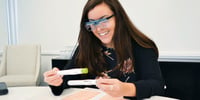Will Apple’s Watch Make Medical History?
/ in apple watch , industrial design , innovative technology , medical product design , news , wearables / by Design ScienceThe wearables market got a big jolt this past month with the release of Apple’s new Watch. It’s just called Watch, by the way, not iWatch—because that would be creepy.
But Watch isn’t just one more “thing” from Apple. It’s an integrated device that aims to bring together a gyroscope and an accelerometer, along with the GPS and Wifi from your iPhone to “establish and suggest goals and reward fitness milestones,” said Jonathan Ive, Apple's Senior Vice President of Design, in a prepared video.
The Watch’s most intriguing feature is the Taptic Engine. The Watch can track the wearer’s heart rate and enable users to send their heart rate via text message to another user’s Watch. The Taptic Engine allows the receiver to hear and feel the heart rate.
Fitness also figured highly into the development of Watch, tracking physical activity through the Activity App and the Workout App. Users can not only track intense exercise, but they can also see how much time is spent standing or in simple movement.
Watch should move in conjunction with Apple’s HealthKit, a fitness integration and data aggregation platform that Apple is developing. HealthKit is supposed to allow third-party developers, possibly including healthcare providers, to import personal health data from a wide range of health wearables and use it in their own apps (with the permission of the user, of course).
The question is whether or not Apple’s watch is poised to revolutionize healthcare. Venture Beat spoke to Welltok CEO, Jeff Margolis, who told the online magazine, “Apple—innovative as they may be—will likely not be a major driver of change in healthcare.” But he did say that Apple could make personal health technologies more “ubiquitous.” And given the company’s history of success with MP3 players, smart phones, tablets, and even mini tablets, there is an air of inevitable triumph around Apple’s latest gadget.
There is some indication that Apple is planning for future adaptations that could enhance the wellness aspect of the technology. Again, Venture Beat’s Mark Sullivan noted that before the launch, Apple said the watch would contain 11 sensors to improve biometric measurement possibilities. “But the inclusion of both visible light and infrared sensors suggests a focus on accuracy, something badly lacking in other consumer health wearables.”
Such attention to accuracy opens up a spectacular range for health app developers. Ultimately, it will be up to them to create ways to use Apple’s hardware. As always, Apple has positioned itself to enable other peoples’ visions.
Share this entry
-
Share on Facebook
Share on Facebook
-
Share on Twitter
Share on Twitter
-
Share on Google+
Share on Google+
-
Share on Linkedin
Share on Linkedin
-
Share by Mail
Share by Mail











